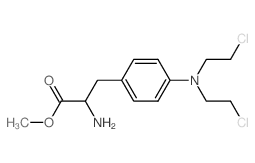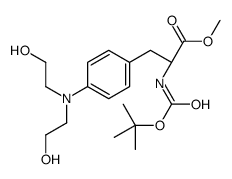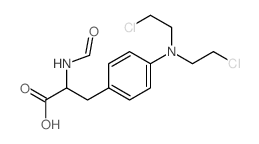148-82-3
| Name | melphalan |
|---|---|
| Synonyms |
4-[Bis(2-chloroethyl)amino]-L-phenylalanine
L-3-[p-[Bis(2-chloroethyl)amino]phenyl]alanine melphalan L-Phenylalanine, 4-(bis(2-chloroethyl)amino)- 2-Amino-3-[4-[bis(2-chloroethyl)amino]phenyl]propanoic acid MFCD00057717 Alanine, 3-(p-(bis(2-chloroethyl)amino)phenyl)-, L- (2S)-2-amino-3-{4-[bis(2-chloroethyl)amino]phenyl}propanoic acid L-Phenylalanine, 4-[bis(2-chloroethyl)amino]- Sarcoclorin 3025 C.B. L-Phenylalanine mustard EINECS 205-726-3 p-Di(2-chloroethyl)amino-L-phenylalanine 3-(4-bis(2-chloroethyl)aminophenyl)-L-alanine 3-[p-[Bis(2-chloroethyl)amino]phenyl]-L-alanine |
| Description | Melphalan is an effective DNA alkylating agent, with potent antitumor activity. |
|---|---|
| Related Catalog | |
| Target |
DNA Alkylator/Crosslinker[1] |
| In Vitro | Melphalan is a DNA alkylating agent, used for multiple myeloma[1]. Melphalan-DNA adducts can be visualised in both cultured cells and solid tumour tissue[3]. |
| In Vivo | Melphalan (12 mg/kg, i.p.) increases pharmacological activity with heat in SD rats[2]. |
| Cell Assay | Melphalan cytotoxicity is determined by an MTT assay. The cells are seeded at 1000 cells per well in a 96-well microtitre plate in 100 μL culture medium to obtain approximately 4000 cells per well after 2 days at 37°C, 5% CO2. Then, the cells are washed and exposed to 0, 10, 25, 50, 100, 250 or 500 μM melphalan for 1 h at 37°C, 5% CO2. To control for cytotoxicity from hydrochloric acid, the solvent for melphalan, cells are also exposed to hydrochloric acid at a concentration adjusted to the highest concentration of melphalan (500 μM). After treatment the cells are washed twice with culture medium and 100 μL fresh culture medium is added. The day after exposure to melphalan another 100 μL fresh culture medium is added. After an additional 2 days the culture medium is removed and 200 μL fresh culture medium is added. At day 4 after treatment the culture medium is removed and cells are incubated for 4 h with 100 μL fresh culture medium and 10 μL MTT-labelling agent. Subsequently, 100 μL solubilisation solution (10% (v/v) in 0.01 M HCl) is added. After incubation overnight the absorbance at 590 nm is measured by a microtitre-plate reader[3]. |
| Animal Admin | Rats[2] Twenty rats are randomized into two groups according to the intraperitoneal temperature. The normothermic (NT) group receives intraperitoneal chemotherapy with intraperitoneal temperatures maintained between 32.5 and 34.5°C, and the hyperthermic (HT) group receives intraperitoneal chemotherapy with intraperitoneal temperatures maintained between 41.5 and 42.5°C. Melphalan at a dose of 12 mg/kg is diluted in 150 mL 0.9% NaCl solution immediately before administration. A closed perfusion system is utilized. The perfusate is heated in a tube coil in a thermostatically regulated water bath and infused into the peritoneal cavity with a roller pump at a rate of 80 mL/min for 90 min. Rhythmic massage of the abdomen is used to facilitate uniform heat distribution within the peritoneal cavity. When the proper temperature for the experiment is reached inside the peritoneal cavity, melphalan is added to the perfusate in the reservoir. For each animal, 0.5 mL peritoneal fluid and 0.5 mL blood are collected at 5, 15, 30, 60, and 90 min after the initiation of chemotherapy. The venous catheter is flushed with 0.2 mL of heparinized saline after each blood sampling. At the end of the procedure the rats are killed and tissues samples are taken[2]. |
| References |
| Density | 1.3±0.1 g/cm3 |
|---|---|
| Boiling Point | 473.1±45.0 °C at 760 mmHg |
| Melting Point | ~180 °C |
| Molecular Formula | C13H18Cl2N2O2 |
| Molecular Weight | 305.200 |
| Flash Point | 239.9±28.7 °C |
| Exact Mass | 304.074524 |
| PSA | 66.56000 |
| LogP | 1.79 |
| Vapour Pressure | 0.0±1.2 mmHg at 25°C |
| Index of Refraction | 1.597 |
| Storage condition | -20?C Freezer |
| Water Solubility | 95% ethanol and 1 drop 6 N HCl: 0.05 g/mL, clear | <0.1 g/100 mL at 22 ºC |
CHEMICAL IDENTIFICATION
HEALTH HAZARD DATAACUTE TOXICITY DATA
MUTATION DATA
|
| Symbol |


GHS06, GHS08 |
|---|---|
| Signal Word | Danger |
| Hazard Statements | H300-H310-H330-H350-H361 |
| Precautionary Statements | P201-P260-P264-P280-P284-P302 + P350 |
| Personal Protective Equipment | Eyeshields;Faceshields;Gloves;type P2 (EN 143) respirator cartridges |
| Hazard Codes | T+:Verytoxic; |
| Risk Phrases | R45;R46;R26/27/28;R63 |
| Safety Phrases | S53-S22-S36/37/39-S45 |
| RIDADR | UN 2811 6.1/PG 2 |
| WGK Germany | 3 |
| RTECS | AY3675000 |
| Packaging Group | II |
| Hazard Class | 6.1(a) |
| HS Code | 2922499990 |
|
~% 
148-82-3 |
| Literature: US2012/116117 A1, ; Page/Page column 2 ; |
|
~% 
148-82-3 |
| Literature: US2012/116117 A1, ; |
| Precursor 2 | |
|---|---|
| DownStream 2 | |
| HS Code | 2922499990 |
|---|---|
| Summary | HS:2922499990 other amino-acids, other than those containing more than one kind of oxygen function, and their esters; salts thereof VAT:17.0% Tax rebate rate:9.0% Supervision conditions:AB(certificate of inspection for goods inward,certificate of inspection for goods outward) MFN tariff:6.5% General tariff:30.0% |




